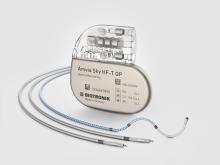Preventing AF How Closed-Loop Stimulation Supports Proactive Heart Care
Atrial Fibrillation (AF) is the most common sustained arrhythmia, affecting millions worldwide, and can lead to stroke, dementia and heart failure. As such, it demands forward-thinking, early action. At BIOTRONIK, we focus on proactive care with innovative cardiac technologies that can help prevent, detect, monitor and treat AF. In line with this mission, our Closed-Loop Stimulation (CLS) technology offers a smarter, more responsive rate adaptation solution to manage heart rhythm disorders, helping prevent AF before it starts. CLS has been proven to reduce the risk of AF and support patients during not only physical but also emotional stress—something traditional DDDR pacemakers fail to do.
Below, we’ll explain how CLS works and detail the clinical data supporting physiologic pacing’s advantages over DDDR for AF prevention.

Smarter Pacing: What CLS Does Differently
Daily life brings both physical and emotional stressors, which can be especially risky for patients with sinus node dysfunction (SND), whose hearts struggle to respond with adequate cardiac output. Pacemakers are often used to treat SND, a condition that disrupts the heart’s natural rhythm, causing fatigue, dizziness, or fainting. However, traditional rate-adaptive pacemakers adjust heart rate based solely on movement, causing them to miss and fail to respond to the metabolic demand caused by emotional stress. Closed-Loop Stimulation (CLS) technology is smarter: it uses real-time signals from the heart to adjust pacing[i], supporting pacemaker patients during both physical and emotional stress and adapting each heartbeat to meet the body’s cardiac demands.
CLS pacemakers are more advanced and responsive options for people with SND, and as a result of the improved rate adaptation, CLS pacing has also been proven to increase patient performance by 7% during daily activities in comparison to DDDR.[ii]
Here’s how it works:
- CLS continuously analyzes the patient’s myocardial contraction dynamics (inotropy), detecting changes in contraction strength and speed through impedance measurement
- When the body needs more blood flow (e.g., during exercise or stress), the heart naturally contracts faster or harder
- CLS instantly recognizes these subtle changes and automatically adjusts the pacing rate, keeping cardiac output in sync with the body's immediate needs
Working in real time, CLS integrates with the body’s regulation of cardiac output and mimics a healthy heart’s natural responses to physical activity, emotional stress, and other triggers. It’s a forward-thinking, intelligent approach to pacing—designed to work with the body, and respond to it.
CLS is Backed by Clinical Data
With regards to AF prevention, the data is clear: using CLS pacemakers in certain patients has been shown to reduce episodes of abnormal heart rhythms more effectively than standard DDDR pacemakers. A 2024 randomized controlled trial, The Clinical Benefits of the Closed Loop Stimulation in Sinus Node Disease (‘B3’ study), found that CLS-mediated pacing offers a significant 16% relative risk reduction in subclinical AF episodes, especially those of longer duration, compared to conventional DDDR pacing.[iii] Notably, the greatest benefits were seen in patients without prior atrial fibrillation or atrioventricular block, suggesting CLS may be most effective as a preventative therapy in earlier-stage patients.
The B3 study involved 1,210 patients with sinus node dysfunction (SND) implanted with dual-chamber devices. They were followed for three years: 612 received CLS-enabled pacing, and 598 received conventional accelerometer-based DDDR pacing. The primary endpoint was the time to the first occurrence of a composite outcome, which included: an atrial high-rate episode (AHRE, now referred to as DDAF following new guidelines) lasting ≥6 minutes, stroke, or transient ischemic attack (TIA). Over three years, CLS pacing significantly reduced the incidence of the primary endpoint compared to DDDR (50.6% vs. 55.7%). They reported a hazard ratio (HR) of 0.84 (95% CI: 0.72–0.99; P=0.035), indicating a 16% risk reduction. This effect remained after adjusting for CHA₂DS₂-VASc scores (HR 0.84; P=0.033). Stroke/TIA incidences were rare (1.3%) and occurred at similar rates in both CLS and DDDR groups, indicating that DDAF reduction drove most of the benefit.
The study also found, in a post hoc analysis of DDAF incidence by subgroups, that the risk reduction for patients without AV block and patients with no history of AF was even greater. For these patients, CLS pacing provided a:
- 23% lower risk of DDAF for patients without AV block
- 27% lower risk for those without prior history of AF
These findings highlight CLS as a promising technology for AF prevention in SND patients, potentially reducing AF onset, progression and related complications. By adapting to the body’s real-time physiologic needs—responding beat-by-beat to both physical and emotional stress—CLS provides improved rate-adapted pacing and proactive care. For physicians, this means a smarter tool for pacing, reducing the risk of AF, and improving long-term outcomes with confidence.
Stay tuned for more insights into how BIOTRONIK’s key cardiac technologies are helping doctors prevent and manage AF, as part of our September blog series for AF Awareness Month.
[i] Gargaro A, Biancalana G, Botto GL, Brignole M. The clinical role of closed loop stimulation pacemakers in the treatment of patients with sinus node dysfunction: a review. Future Cardiol. 2025 Jun;21(8):567-578. doi: 10.1080/14796678.2025.2507464. Epub 2025 May 19. PMID: 40388576; PMCID: PMC12150642.
[ii] Abi-Samra FM, Singh N, Rosin BL, DwyerJV, and Miller C. Europace. 2013; 15: 849-856.
[iii] Wang CC, Merkely B, Lin LY, Oh IY, Bertaglia E, Saporito D, Menichelli M, Nicosia A, Carretta DM, Coppolino A, Ching CK, Del Castillo ÁM, Su X, Del Maestro M, Giacopelli D, Gargaro A, Botto GL. Closed loop stimulation reduces the incidence of atrial high-rate episodes compared with conventional rate-adaptive pacing in patients with sinus node dysfunctions. Europace. 2024 Jul 2;26(7):euae175. doi: 10.1093/europace/euae175. Erratum in: Europace. 2024 Aug 3;26(8):euae217. doi: 10.1093/europace/euae217. PMID: 38938169; PMCID: PMC11226787.




